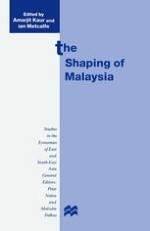1999 | OriginalPaper | Buchkapitel
Economy and Society
The Formation of a National Economy
verfasst von : Amarjit Kaur
Erschienen in: The Shaping of Malaysia
Verlag: Palgrave Macmillan UK
Enthalten in: Professional Book Archive
Aktivieren Sie unsere intelligente Suche, um passende Fachinhalte oder Patente zu finden.
Wählen Sie Textabschnitte aus um mit Künstlicher Intelligenz passenden Patente zu finden. powered by
Markieren Sie Textabschnitte, um KI-gestützt weitere passende Inhalte zu finden. powered by
In the mid 1990s, Malaysia was well on the way to approaching Newly-Industrialised Country (NIC) status. In 1990, for example, nearly 27 per cent of GDP came from manufacturing industry. Nothwithstanding this, it is evident though that the level of industrialisation varies between East and Peninsular Malaysia, with the process being much more advanced in the latter. Moreover, the emergence of an integrated national economy was a slow process, arising from differing geographical locations, resource endowments and the cultural and ethnic backgrounds. The key to understanding uneven economic development in the Malaysian federation lies also in its historical and recent past and it is the aim of this chapter to examine and compare the pace of economic and social change in Peninsular and East Malaysia, taking a long-term view of their economic growth. The chapter concentrates on economic development prior to the Second World War, but also links the pre- and post- World War II periods. The chapter is structured in three parts. The first and major part focusses on economic and social change from about 1850 to 1940. It is argued that the foundations of an export-oriented economy and plural society were laid during this period. The second part analyses economic change from about 1946 to 1963 when colonial policies in Sabah and Sarawak brought these states closer to Malaya so that by the time of federation in 1963, the foundations of an integrated Malaysian economy had emerged.
